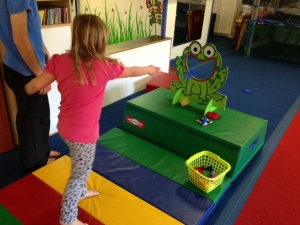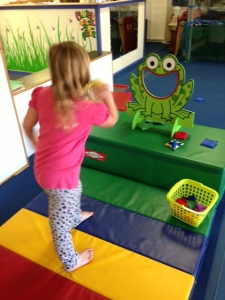The old potato sack “ain’t” what it used to be. This version of the classic potato sack is made more “kid-friendly” with the addition of pictures of animals that really do “jump” on the front of the sack—kangaroos, rabbits and frogs—and with two sets of handles to accommodate any age (3 to 103 years young!) One set of handles is on the inside of the sack for little hands and the other is on the outside of the sack for bigger hands. Once your body is standing inside the sack, there is only way to move from one place to another and that is by grasping the handles and using both feet to JUMP up and down. Hopping is on one foot and is not a recommended way to travel while in a sack. It is best to play the following activities outside on the grass or on any cushioned or matted surface. Whether you’re playing a game or competing in a race, you’ll have fun and experience success—no matter what your size!

Objectives/Learning Outcomes:
Playing and using the sacks promotes and develops…
1. Overall physical fitness—cardiovascular endurance, flexibility, muscular strength and endurance.
2. Gross motor development—using the large muscles of the arms, legs and trunk.
3. Bilateral coordination—using both sides of the body at the same time in unison as in jumping.
4. Eye-foot coordination—eyes and feet working together smoothly to meet a challenge.
5. Spatial awareness—coordinated movement in relationship to other objects in the environment.
6. Balance—being able to hold the position of the body through the interaction of muscles working together (maintaining body equilibrium) whether the body is stationary (static balance) or moving (dynamic balance).
7. Cooperation and teamwork—2 or more people working and playing together rather than against one another, just for the fun of it.
8. Fun— playful actions providing amusement and enjoyment.
9. Listening skills—ability to follow verbal directions.
Games & Activities
Animals Jump Ages: 3 – 5
Set Up:
1. Players scattered in open space.
2. One jumping sack for each player.
Procedure:
1. Before starting this activity, discuss with the group about what jumps and what doesn’t.
2. An adult or child who understands the concept of the activity is selected to be the leader of the game.
3. Players stand inside jumping sack but do not hold handles.
4. The leader shouts out various things that jump.
5. Each time the leader names anything that “jumps” the players grab the handles of the sack, pulling it up, and jump up and down vigorously (e.g., “frogs jump,” “rabbits jump,” “kangaroos jump,” “crickets jump,” etc.).
6. If the leader names something that does not jump, players let go of their bags and stand motionless (e.g., “elephants jump,” “worms jump,” “tables jump,” etc.).
Animals Find Your Home Ages: 3 – 5
Set Up:
1. One animal jumping sack and one hoop or shape spot marker for each player.
2. Arrange hoops or spot markers in a large circle equally spaced apart.
Procedure:
1. Position each player (standing in jumping sack) in a hoop or on a spot (the hoop or spot is their “home”).
2. One player in a sack stands in the center of the circle without a hoop or spot and calls out, “KANGAROO (name of animal sack they are in) WANTS A HOME!” (e.g. “RABBIT WANTS A HOME!”). All animals (including the one standing in the center) must leave their home (hoop or spot) and jump to a different and vacant spot or hoop.
3. One player will be left without a hoop or a spot and should then take his or her place in the center as the next animal home shopper.
4. The game continues until everyone has had a turn to be a new “home shopper.” If “home shoppers” are too slow in finding a new spot or hoop, an adult or leader may pick the next home shopper randomly.
Listen & Jump Ages: 3 – 5
Set Up:
1. Players scattered in open space.
2. One jumping sack for each player.
3. CD player and lively upbeat music.
Procedure:
1. First ask the players to jump in place when the music starts.
2. When the music stops, the players are to stop and maintain their balance while standing in the sack.
3. Challenge the players to jump freely around the open space while the music is playing.
4. The game continues with the starting and stopping of the music.
Animal Facts Ages: 5 and up
Set Up:
1. “Start” and “Finish” lines or boundaries using cones, ropes or other markers placed a maximum of 12 – 20 feet apart.
2. One jumping sack for each player.
Procedure:
1. Each player stands behind the boundary or start line at least an arms width apart from each other.
2. Each player gets into an animal sack, pulls it up, and holds onto the size-appropriate handle. Make sure each player knows which animal sack they are in—kangaroo, rabbit or frog.
3. An adult or child who understands the concept of the activity is selected to be the leader of the game.
4. The leader of this activity calls out animal facts and if the information is correct for the animal—kangaroo, rabbit or frog— that player(s) in the appropriate sack jumps forward one jump.
5. Each time a fact is called out, the matching animal or animals jump forward one jump. If the animal fact does not apply to the animals, nobody jumps forward.
6. The game ends when all the animals cross the finish line.
Some Animal Facts or Characteristics that you can use in playing this game:
Ask questions appropriate for the ages of children playing.
Encourage the children to add more animal facts to this list.
This animal lays eggs (frog).
This animal is a mammal (rabbit, kangaroo).
A tadpole becomes one of these (frog).
Bunny is another name for this animal (rabbit).
This animal’s skin is smooth (frog).
This animal eats grass (rabbit, kangaroo).
A group of these animals is a herd (kangaroo).
Babies are called joeys (kangaroo).
This animal is a marsupial mammal (kangaroo).
This animal is an amphibian (frog).

Races & Relays
Individual Jumping Races Ages: 5 and up
Set Up:
1. “Start” and “Finish” lines or boundaries using cones, ropes or other markers placed a minimum of 12 feet apart (place farther apart for older ages).
2. One jumping sack for each player.
Procedure:
1. Each player stands behind the boundary or start line at least an arms width apart from each other.
2. Each player gets into a sack, pulls it up, and holds onto the size-appropriate handle.
3. On the signal “GO!” players jump to the finish line.
4. Every player who crosses the finish line is a winner!
Variations:
1. Have players try and beat their own previous time.
2. If not enough sacks for everyone, let those watching be cheerleaders and encourage the players by rooting for their favorite animal—“Go Rabbits!” or “Jump Frogs Jump!” etc.
Animal Team Jumping Races Ages: 5 and up
Set Up:
1. “Start” and “Finish” lines or boundaries using cones, ropes or other markers placed a maximum of 12 – 20 feet apart.
2. One jumping sack for each player.
Procedure:
1. Players pair up or group together by the type of animal on their sack.
2. Each animal team lines up single file behind the starting line.
3. On the signal “GO!” players jump to the finish line, turn around, jump back to the start line.
4. Upon crossing the start line the next player in the same animal team jumps to the finish line, turns around, and jumps back to the start line.
5. Game continues until each animal player in the team has a turn.
Variations:
A. Have same animals stand across from each other on opposite sides of the boundary lines. When one team member jumps across the line, the next team member on that side jumps to the other side and crosses the opposite boundary line.
B. Make animal teams consisting of equal numbers of kangaroos, rabbits and frogs.
Three-Legged Animal Race Ages: 5 and up
Set Up:
1. “Start” and “Finish” lines or boundaries using cones, ropes or other markers placed a maximum of 12 – 20 feet apart.
2. One jumping sack for each two-person team.
Procedure:
1. Players pair up and become a two-person team and pick an animal sack of their choice.
2. Each team stands side-by-side and puts the leg closest to each other in the jumping sack, standing behind the starting line.
3. On the signal “GO!” each two-person team jumps to the finish line.
4. Every team who crosses the finish line is a winner!
Variation:
1. This race can be done as a relay too, with additional two-person teams in the same animal sacks (kangaroos, rabbit or frog) in a line behind the same type animal team. The first pair crosses the finish line, gets out of their sacks and runs back to the starting line, tagging the next members of their animal team, permitting them to now race to the finish line.
Discount School Supply® Product Recommendations:
Animal Hopping Sacks – set of 6 (HOPPY)
Brawny Tough Activity Hoops – set of 15 (HOOPSET)
Shapes Spots – set of 18 (SHSPOT)
Hamilton™ AM/FM CD Player (BOOMBOX)
Popular Children’s Songs CDs – set of 4 (TODCDS)
Colored Cones – set of 10 (SETC)
7′ Nylon Jump Ropes – set of 3 (RPST)






















